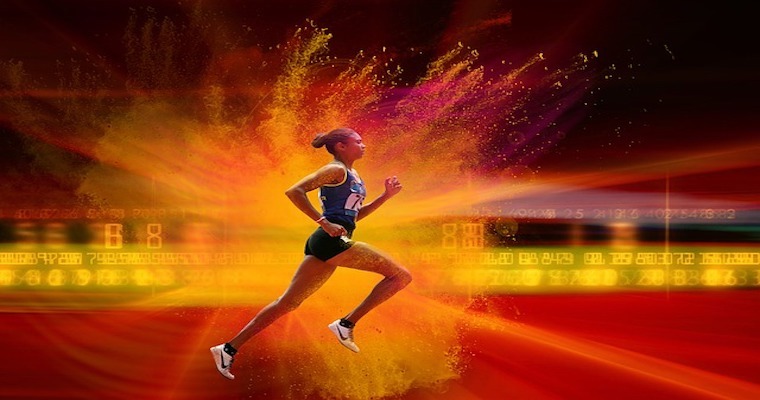
Few topics in sport psychology have aroused as much interest as anxiety and this is hardly surprising given the stressful nature of competitive sport settings which can lead to anxiety. It is why athletes often seek the services of a sport psychologist to help with stress management.
Anxiety is characterized by feelings of apprehension and tension along with activation or arousal of the autonomic nervous system (Spielberger, 1966). Thus, anxiety may comprise cognitive (e.g., feelings of apprehension) and physiological (e.g., increased activation of the autonomic nervous system) changes. Competitive anxiety is the anxiety experienced by individuals when placed in a competitive situation, such as a tennis match or swimming gala. The symptoms of competitive anxiety are common to many athletes and examples include increased heart rate, negative thoughts, sweaty palms, images of failure, and butterflies in the stomach.
Most athletes would accept that competitive sport settings can be anxiety inducing. Although athletes desire success they are up against opponents who are equally determined to succeed, are often watched by an audience who are either supportive or hostile (but rarely indifferent), and in many sports the threat of injury, pain, or discomfort is all too real. In short, there is the possibility of public failure, disapproval by significant others, and physical harm. The ability to cope with anxiety is integral to success in competitive sport. Indeed, the term “sport experiment” has been coined implying that the ability to cope with the pressure of competition, which may lead to increased anxiety levels, is the key factor that will determine success given that athletes, particularly at the elite level, are well matched, technically and physically (Patmore, 1986). Even minor fluctuations in this ability may result in substantial changes in performance and outcome. For example, a slight alteration in a golfer’s putting stroke from an increase in anxiety-induced muscular tension may be the difference between a successful or unsuccessful putt.
For some people competitive anxiety can be considered multidimensional, comprising both cognitive and somatic components (Martens, Burton, Vealey, Bump, & Smith, 1990). Cognitive anxiety refers to “… fear of failure and negative expectations about performance” while somatic anxiety refers to “… individuals’ perceptions of their physiological state” (Hardy, Jones & Gould. 1996; p. 142). Adopting a multidimensional approach to the study of competitive anxiety meant that an individual could be high in cognitive anxiety and low in somatic anxiety, or vice versa, high in both or low in both. Cognitive anxiety is proposed to remain constant in the lead up to competition while somatic anxiety, will rise in response to stimuli signalling the onset of competition, such as arriving in the changing room (Parfitt et al., 1990). Somatic anxiety is then proposed to dissipate once competition begins and because of this it is cognitive anxiety that will have the greatest influence on performance (see Burton, 1988). Cognitive and Somatic anxiety are proposed to covary in stressful situations, that is one can influence the other (Martens et al., 1990). For example, a golfer about to take a crucial putt who notices his heart is racing may become worried that he is not sufficiently relaxed to perform well. Similarly, an ice skater who is worried about a particular move she has to execute may find that her heart starts racing in response to these negative thoughts. This is why sport psychologists often use different techniques for stress management comprising cognitive (e.g., self-talk) and somatic (e.g., breathing techniques).
How these aspects of anxiety relate to performance can vary. For example, in swimmers there was an inverted-U relationship between somatic anxiety and performance and a negative relationship between cognitive anxiety and performance, where greater levels of worry were associated with worse performance (Burton, 1988). Although similar findings to this have not been seen in all studies and it is probably correct to say that the relationship between anxiety and performance is a complex and can vary across individuals. That is why it helps to find a sport psychologist to talk through your approach to manging anxiety in competition and develop some appropriate stress management techniques. You can get the sport psychology support you need by searching our directory of sport performance consultants.
References cited
Burton, D. (1988). Do anxious swimmers swim slower? Re-examining the elusive anxiety-performance relationship, Journal of Sport Psychology, 10, 45-61.
Hardy, L., Jones, G., & Gould, D. (1996). Understanding psychological preparation for sport: Theory and practice of elite performers. Chichester, England: John Wiley & Sons.
Martens, R., Burton, D., Vealey, R. S., Bump, L. A., & Smith, D. E. (1990). Development and validation of the Competitive State Anxiety Inventory - 2. In R. Martens R. S. Vealey, & D. Burton (Eds.), Competitive anxiety in sport (pp. 117-190). Champaign, IL: Human Kinetics.
Parfitt, C. G., Jones, J. G., & Hardy, L. (1990). Multidimensional anxiety and performance. In G. Jones and L. Hardy (Eds.), Stress and performance in sport (pp. 43-80). Chichester, England: Wiley.
Patmore, A. (1986). Sportsmen under stress. London: Stanley Paul.
Spielberger, C. D. (1966). Theory and research on anxiety. In C. D. Spielberger (Ed.), Anxiety and behavior (pp. 3-22). New York: Academic Press.
Image by Thomas Wolter from Pixabay
